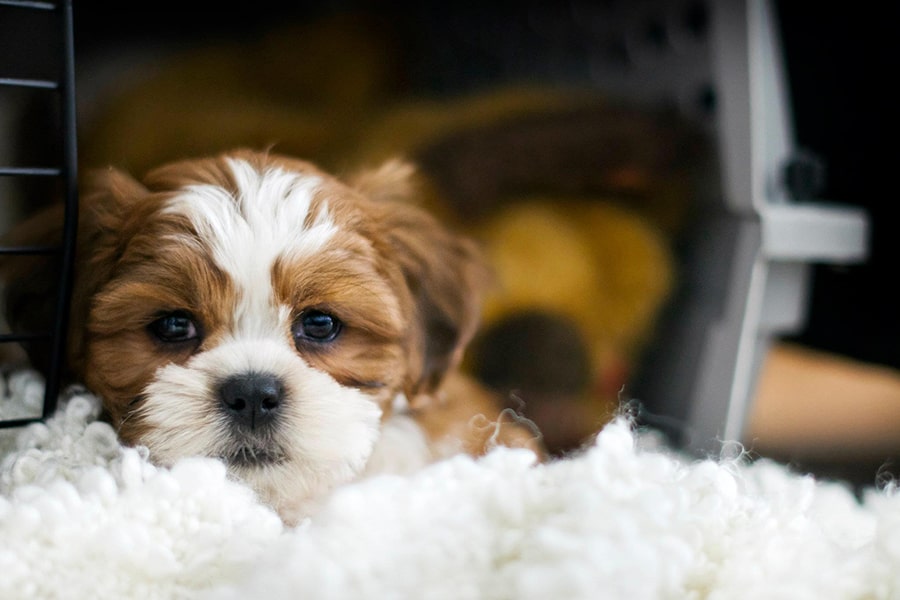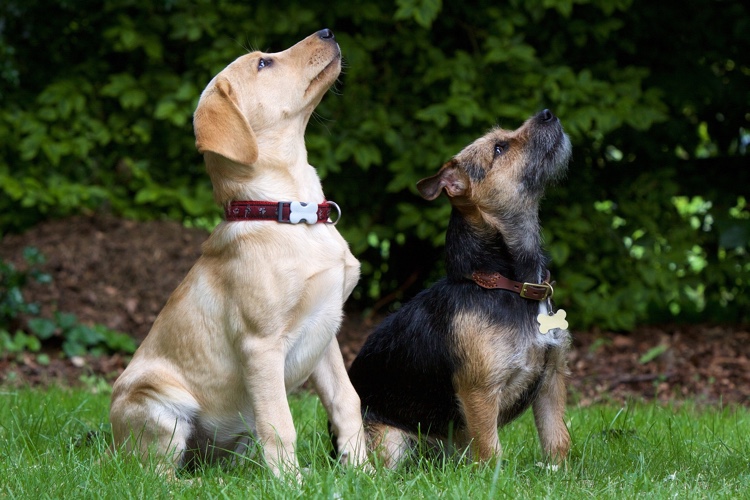
Dogs are our loyal companions, so it’s not surprising that they can feel anxious when they’re separated from their loved ones. Separation anxiety in dogs is a common problem that can lead to unwanted behaviors, like destructive chewing, howling, or peeing around the house. Luckily, there are things you can do to help your dog better handle time alone.
What Are the Signs?
Dogs with separation anxiety may act fidgety or stressed, particularly as you’re getting ready to leave. For instance, they might whine or act very clingy. You may even notice your dog pacing back and forth, probably near the door. Other signs of separation anxiety can include:
- Going potty in the house – If your typically well-housetrained pup starts going to the bathroom around the house while you’re away, separation anxiety could be the cause. Incontinence can also happen because of certain health conditions, like a urinary tract infection, so it's a good idea to visit your veterinarian to rule out any underlying illnesses.
- Howling or excessive barking – Lonely dogs might express their anxiety or frustration vocally with a lot of loud howling or barking. This can be upsetting for the dog as well as any neighbors who are forced to listen to those cries.
- Destructive chewing – Shoes, pillows, clothing, table legs, and other household items can all be at risk of being chewed on when a dog has separation anxiety.
- Attempting to escape – Dogs with separation anxiety may chew or scratch at doors and windows in an attempt to get out. These behaviors can damage your home and cause injury to your dog, who could fracture a tooth or get cuts on their paws. Of course, it’s also problematic if your dog does manage to get out of the house and gets lost or hurt.
All of these behaviors can be stressful for dogs and their families. They can even lead to dog parents giving up their four-legged friends to another home or shelter out of frustration. This is one of the reasons why ASPCA Pet Health Insurance offers coverage for behavioral conditions. This coverage reimburses dog parents for the costs of treating these issues, which can encourage them to seek professional assistance before considering drastic action.
What Causes Separation Anxiety?
It’s not completely understood why some dogs have separation anxiety, but it is thought to be more prevalent in dogs who have been adopted from shelters than those raised by a single family since they were puppies. This isn’t necessarily related to a dog’s experience at the shelter. The dog might have been brought to the shelter because of issues with separation anxiety and then has the same problems when placed in a new home. It also often comes up as a reaction to changes in lifestyle or routine, such as:
- A sudden shift in schedules, like when children go back to school or the dog parent gets a new job with different hours
- A close family member moving out of the home or someone new moving in
- A new baby in the home, which can mean less attention for the family dog
- Moving to a new house or apartment
If your family is experiencing one of these situations, you can help your dog by trying to keep things as familiar as possible. For instance, in the case of moving to a new home, you can maintain your dog’s feeding schedule and even put food and water bowls in a similar location to your old residence. It’s also helpful to bring older items, like your dog’s favorite pet bed or toys, rather than getting new ones right away.

Can It Be Treated?
Yes, separation anxiety can be treated. So, what helps dogs with separation anxiety? In some cases, you may simply need to wait for your dog to get used to a new situation. In other cases, you may need to be more proactive and try out strategies like these to help your dog.
1. Desensitize Your Dog to Your Departure
This is a process where you gradually get your dog comfortable with being left home alone. Basically, you repeat an activity, such as picking up your keys or opening the coat closet, but not leaving until your dog can watch you do it without getting anxious or upset. It takes a lot of patience and certainly isn’t for everyone. If you want to try desensitization, it can be helpful to enlist professional help from a dog trainer, certified applied animal behaviorist, or a veterinary behaviorist.
2. Avoid Reinforcing Certain Behaviors
Ignore attention-seeking behaviors, like whining or bumping up against your legs, while you’re getting ready to leave the house. If you respond to these types of behaviors, it will only encourage your dog to do them more. After all, they work!
3. Keep Arrivals and Departures Calm
Even if you hate the idea of leaving your four-legged friend, do your best to stay calm as you say goodbye. If you make a big deal about leaving, it can amplify your dog’s anxiety over being left home alone. Speak quietly in a relaxed voice and give your dog a simple pat on the head as you go out.
Similarly, make sure you keep things calm when you come back home. If your dog is jumping up and down or doing a crazy four-legged greeting dance, it’s best not to encourage them. Wait for your dog to calm down and put four paws on the floor before you greet them.
4. Wear Out Your Dog Before You Go
Exercise is a great remedy for anxiety and can help relieve feelings of boredom and frustration that might be exacerbating the situation. Take your dog for a long brisk walk, play a game of fetch, or engage in an energetic round of tug of war before you go out. This way, you can leave behind a calmer, more content pooch.
5. Feed Your Dog Before You Leave
Just like exercise, a full belly can help your dog feel satisfied and relaxed. Schedule a mealtime before you need to leave the house for the day. You can also hide some treats around the house for your dog to discover during the day.
6. Leave a Puzzle Treat
Make it a point to give your dog a treat-filled puzzle toy right before you leave the house. This can help your dog associate the joy and excitement of getting a toy with you going out the door. Plus, it will help keep them occupied while you’re gone.
7. Crate Your Dog
Dogs who are properly crate trained will be more comfortable when left in their safe and cozy den. You can leave the crate door open so your dog can come in and out as they please. If you choose to close the crate, make sure your dog has access to water while you’re gone.
8. Turn on the TV
Leave the TV on for your dog when you go out. The lights and noises can be comforting and make your dog feel a little less lonely. The nature channel is a good choice if your dog enjoys watching other animals. Putting the radio on a soothing station can also be helpful if you don’t want the TV on all day.
9. Hire a Dog Walker
If you’re going to be gone longer than usual or your dog just can’t seem to manage while you’re away, you should consider hiring a dog walker. You can also ask a trusted neighbor or friend to stop in and spend a little time with your dog, if possible. Doggie daycare is another option. It can be more costly, but it lets your dog spend the day romping around with their four-legged friends rather than being lonely and possibly getting into trouble at home.
10. Seek Professional Help
Veterinarians and certified applied animal behaviorists are great resources to help with separation anxiety in dogs. They can help with desensitization or recommend other behavioral techniques to solve the issue. Medications that treat depression or reduce anxiety can also be helpful, although they’re typically reserved for more severe cases and should be combined with behavior modification techniques.

Have a Cat?
Just like dogs, our fine feline friends can suffer from separation anxiety. Thankfully, the things you do to help dogs with separation anxiety can also benefit cats.
For instance, keep your departures and arrivals low key, wear your cat out or feed them before you go, and give them something to occupy themselves with while you’re gone. There are lots of safe cat toys on the market that your cat can play with on their own or make one yourself. You can also leave behind a toy mouse filled with catnip or a few balls for them to bat around.
Considering Costs
Managing the costs associated with an issue like separation anxiety might not be something you considered when you brought your dog or cat home. There can be expenses for medications and treatments, as well as money needed for things like replacing the couch cushions your dog chewed up while feeling anxious. Read more about the hidden costs of pet parenting.
The information presented in this article is for educational and informational purposes only and does not constitute or substitute for the advice of your veterinarian.
Helpful resources for pet parents
Browse categories
-

Have Dog, Will Travel: Traveling with Your Dog
Whether you're road-tripping or flying, make sure you and your pup are prepared for the journey ahead with these tips.
-

How to Keep Cats Warm and Healthy in Winter
Even with their furry coats, cats can get cold in the winter.
-

5 Fun Tricks to Teach Your Dog
You can teach dogs of any age new tricks. Get a full how-to for these easy routines.

Browse Categories
(opens new window)
